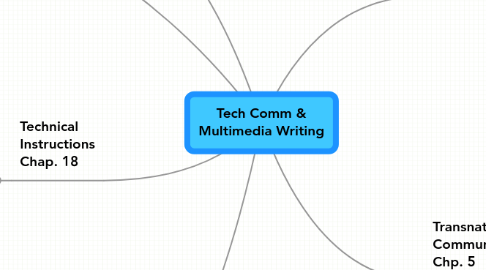
1. Ethics and Technical Instructions
1.1. Functionality
1.2. Safety
1.3. Misue of product
1.4. Hazards even with proper use
1.5. Troubleshooting
1.6. Product liability
2. PSA, Process-5 steps
2.1. Plan
2.2. Research
2.3. Draft
2.4. Review
2.5. Distribute
3. Organizing and Drafting Documents Chp. 7
3.1. The order in which information is presented can be crucial.
3.1.1. Predrafting Strategies - can help eliminate problems when writing a document.
3.1.1.1. Confirm your purpose
3.1.1.2. Analyze you auduence
3.1.1.3. Gather your information
3.1.1.4. Develop ideas about the information
3.1.1.5. Organize your information
3.1.1.6. New node
4. Technical Instructions Chap. 18
4.1. "When all else fails, read the instructions"
4.1.1. Key Elements
4.1.1.1. Title/Title Image
4.1.1.1.1. clear and concise, let the audience know where they will end up.
4.1.1.2. Byline
4.1.1.2.1. information that tells the audience imformation about the company responsible for the instructions
4.1.1.3. Date
4.1.1.4. Introduction
4.1.1.5. Alerts
4.1.1.6. Equiptment Needed
4.1.1.7. Parts List
4.1.1.8. Steps
4.1.2. Quick Reference Card
4.1.3. Help Pages
4.1.3.1. Be clear and concise
4.1.3.2. Be Direct but Friendly
4.1.3.3. Provide examples
4.1.3.4. Provide Links
4.1.3.5. Include Search Feature
4.1.3.6. Consider Context
5. Rhetorically Thinking requires an audience, Exigency and purpose, workplace writers, Context and constraints and Documents.
5.1. New node
6. Transnational Communication Chp. 5
6.1. Culture
6.1.1. How a group of people (religion, politics, education, ethics, economics, and art) understand or interpret communication.
6.2. Language
6.2.1. The target language
6.2.1.1. Understand as much about the target audience as possible. The more you know how your "audience" thinks, the better your document will be more understood.
6.2.2. Official national languages
6.2.2.1. Know your audience's OFFICIAL LANGAUAGE - BY law documents must be presented in all langages. This may eliminate having to translate many times.
6.2.3. International english
6.2.3.1. English used to be the language for global business - considering not many people we due business - using local languages.
6.2.4. Text directionality
6.2.4.1. When doing global business, be aware of how your audience reads documents.
6.2.5. Writing style
6.2.5.1. English writing is more repetitive then French, be understanding that when documents are being translated that you do so in maintaing the accuracy.
6.3. Technology
6.4. Politics and law
6.5. Economics
6.6. Society
6.7. Religion
6.8. Transnational Ethics
6.8.1. Culture may determine ethics, but be in mind that what may be ethically important may not be so appealing to others.
6.9. Transnational Audience (how to write for them)
6.9.1. write clearly
6.9.2. Localize your writing
6.9.3. Account for Visial and Auditory Perceptions
